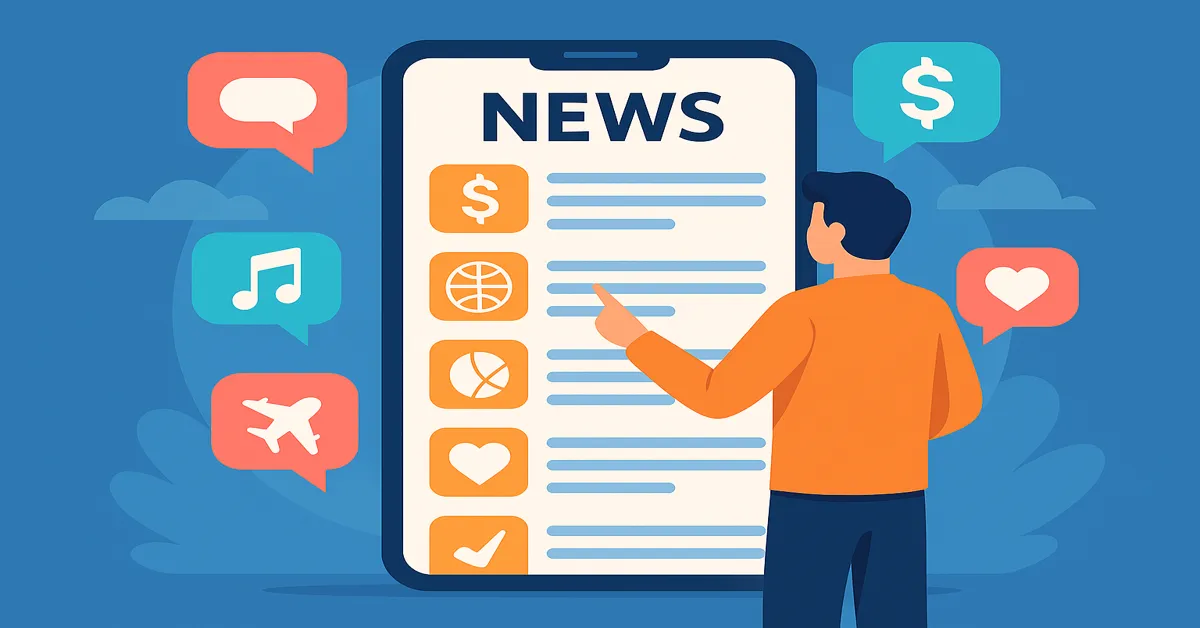In today’s digital age, we no longer consume the news as a singular, linear experience. Instead, we experience “your topics multiple stories”—a dynamic, evolving web of information tailored to our interests, behavior, and context. This shift is transforming not only how stories are told, but also what it means to engage with journalism, news, and content at large. The idea that one story fits all is fading. Instead, you are increasingly part of an ecosystem where your interests shape the stories you see.
This article explores the transformation of media consumption, focusing on how personalization, AI, and multi-format storytelling are giving rise to this new era. We examine the implications for readers, journalists, and the platforms that bridge them. And we address a key question: Is this fragmentation of the news experience enhancing understanding, or quietly isolating us within narrative bubbles?
The Age of Personalization: The Rise of “Your Topics”
When someone talks about your topics in the context of digital content, they are referring to a personalized feed curated based on your reading habits, interests, location, and even your interactions with past articles. This isn’t merely a preference-setting tool—it’s the foundational architecture of how major platforms like Google News, Apple News, and Twitter (now X) serve content.
Today, AI and machine learning algorithms predict the kinds of stories you’re most likely to click on, read through, or share. From hard news to op-eds, sports recaps to cultural critiques, your digital footprint trains the system to prioritize your topics.
But this model goes beyond just convenience. It reflects a philosophical shift: news is no longer centralized. Each reader gets a different version of the truth—packaged, formatted, and sequenced based on what the algorithm believes matters to them.
Multiple Stories: A Fractured Yet Richer Narrative Landscape
In traditional journalism, a single story covered a topic comprehensively. A wildfire, a budget crisis, or a scientific breakthrough would be presented in a unified format, with the assumption that every reader starts with the same knowledge base and context. (Your Topics Multiple Stories)
But today’s content landscape is fractured by design. The same event might yield:
- A live blog tracking minute-by-minute developments
- A three-minute video summary
- A podcast episode
- An opinion column
- A Reddit AMA
- A TikTok explainer
- A data visualization dashboard
- A local angle tailored to your region
This multiplicity is not accidental. It reflects a broader shift toward modular storytelling, where stories are broken down into accessible, platform-native formats.
By offering multiple stories per topic, publishers aim to meet audiences wherever they are—on mobile apps, smart speakers, social media, or wearable devices. Each format isn’t just a retelling; it reflects different values, priorities, and journalistic tones.
Search Intent: What Are Readers Really Looking For?
Behind every search query lies an intent. In the case of “your topics multiple stories,” that intent is not transactional (like buying a product), but informational. Users want:
- A clear understanding of complex issues
- A breadth of perspectives
- A story that resonates personally
- The ability to follow a topic over time
Platforms have responded with topic-based collections. Google calls it “Full Coverage.” The New York Times has “The Story So Far” summaries. Apple News+ offers topic follow-ups, and Twitter/X threads provide crowd-sourced narrative arcs.
This structure reflects a key lesson of the modern news economy: Readers aren’t looking for the news. They’re looking for their news.
The Algorithm as Editor: Pros and Perils
Algorithms increasingly decide which stories rise to the top. While this helps users discover content aligned with their interests, it also comes with risks. (Your Topics Multiple Stories)
Pros:
- Efficiency: Quickly find stories that matter to you
- Diversity of Formats: Access multimedia, not just text
- Customization: Filter out topics you don’t care about
Cons:
- Echo Chambers: You might never see perspectives outside your worldview
- Filter Bubbles: Algorithms may reinforce biases by feeding you what you already believe
- Fragmented Truth: Without a shared starting point, public discourse becomes polarized
The danger lies in invisible curation. Unlike editors, algorithms don’t explain their choices. That opacity can lead to misunderstanding how and why a particular story reached you—or didn’t.
Multiple Stories Across Multiple Audiences
The shift to multi-story storytelling is not only about personalization. It’s also about inclusivity and nuance. Stories told from a singular cultural or national perspective may alienate global audiences.
Consider a major international event like a war, a climate summit, or a pandemic:
- An American reader may want federal policy implications
- A Kenyan reader may need local infrastructure impact
- A Brazilian reader may care about trade relationships
The same topic can and should yield multiple stories—localized, translated, reframed. Media outlets are increasingly hiring cross-cultural reporters, using AI for translation, and designing flexible CMS systems to accommodate narrative diversity.
This is not duplication, but adaptation. In a globalized yet personalized world, multiple stories are essential to provide contextual relevance.
The Role of the Reader: Passive Consumer or Active Curator?
Traditionally, journalism placed the reader in a passive role—open the paper, read what’s there. Today, the reader is an active participant.
You can:
- Choose which topics to follow
- Select preferred formats (text, audio, video)
- Create “story playlists”
- Subscribe to substack newsletters or niche creators
- Interact through comments, shares, and live chats
This interactivity reflects a deeper cultural shift: Readers expect to control their information diet. Platforms that enable this flexibility thrive. Those that don’t, fade.
However, with this power comes responsibility. Curating your own feed means being aware of what you might be excluding. Media literacy is no longer optional—it’s essential.
AI-Generated Stories: The Next Frontier in Multiplicity
AI is not just powering recommendations—it’s writing and localizing content itself. News agencies like the Associated Press and Reuters already use AI for earnings reports, sports recaps, and weather summaries.
What happens when AI creates your topic’s multiple stories in real time?
Imagine this:
- You search “election 2025 update”
- The system generates a unique article summarizing key issues based on your location, political leanings, and preferred reading style
- It cites sources, links to longer reads, and updates dynamically as news breaks
This is no longer hypothetical. Large language models like GPT and others are enabling on-demand, adaptive storytelling. But with power comes concern—how do we ensure factuality, neutrality, and transparency in machine-generated journalism?
The Future of Newsrooms: From Static to Adaptive
Traditional newsrooms were built for a broadcast model—print once, distribute widely. The new model is adaptive: write once, distribute in many forms, for many audiences.
This has implications for staffing and editorial workflows:
- Journalists now work alongside data analysts, UX designers, and AI engineers
- Editorial calendars adapt in real time to traffic spikes and social trends
- Metrics like “time spent” and “scroll depth” shape future coverage
Newsrooms that embrace these changes thrive. Those that cling to static formats risk obsolescence.
Story Arcs, Not Just Headlines
One major advantage of the “multiple stories” model is the ability to follow a topic over time. Rather than reading isolated articles, users can now track:
- Story Arcs: A topic’s timeline, with key milestones and updates
- Character Maps: Who’s who in a developing story
- Explainers: Updated guides that evolve as knowledge deepens
These tools transform the news into a learning journey, helping users build lasting understanding rather than ephemeral awareness.
Ethical Considerations: Whose Stories Get Told?
In a world of infinite content, attention is the true scarcity. This raises uncomfortable questions:
- Do algorithms favor sensational over substantive?
- Which communities are underrepresented in story selection?
- Are marginalized voices amplified or drowned out?
Multiple stories offer an opportunity to redress imbalance—but only if editorial teams remain committed to inclusion, transparency, and journalistic integrity.
Platforms must do more than personalize; they must prioritize diversity of perspective.
The Psychology of Multi-Story Consumption
Neurologically, humans crave narrative—but we also suffer from information fatigue. The multiple-stories model must strike a balance between depth and overload.
Good implementations:
- Offer summaries before deep dives
- Use visual cues to distinguish formats
- Let users customize notifications and digests
- Encourage “completionism” by highlighting what’s been read
These practices not only improve UX but also enhance comprehension, retention, and trust—the pillars of long-term engagement.
Conclusion: A New Kind of News Experience
“Your topics multiple stories” isn’t just a trend—it’s a new paradigm. It reflects our desire for information that’s timely, personal, flexible, and pluralistic. It challenges the idea that journalism must be monolithic and centralized. (Your Topics Multiple Stories)
As this model matures, the winners will be those who:
- Respect user agency
- Balance personalization with perspective
- Leverage technology ethically
- Treat storytelling as both an art and a service
Ultimately, this approach doesn’t just change how we consume news—it changes how we understand the world. In a fragmented media landscape, it offers a mosaic, not a mirror. And in that mosaic lies the potential for empathy, clarity, and informed action.
FAQs
1. What does “your topics, multiple stories” actually mean?
It refers to the personalized delivery of news or content across multiple formats and perspectives, based on your interests. Rather than presenting one version of a story to all readers, platforms now deliver different angles, formats, and depths for the same topic, curated specifically for each user.
2. How is this different from traditional journalism?
Traditional journalism typically offered one comprehensive story per topic, assuming a general audience. The new model focuses on dynamic, adaptive storytelling—often presenting multiple story versions (video, podcast, article, explainer) based on reader preference and platform behavior.
3. Are there risks with personalized news feeds?
Yes. While personalization improves relevance and user experience, it can also lead to echo chambers and filter bubbles. Without diverse perspectives, readers may only encounter stories that reinforce their existing beliefs, potentially distorting their understanding of complex issues.
4. How can readers make the most of this multi-story approach?
By engaging with a variety of formats and sources, and intentionally exploring perspectives outside their comfort zone. Following story arcs, using fact-checked platforms, and customizing feeds mindfully can ensure a richer, more accurate understanding.
5. Is AI responsible for creating or curating these multiple stories?
Increasingly, yes. AI is now used both to curate personalized story feeds and, in some cases, to generate content (like summaries or localized news). While this improves speed and scale, it also raises questions about transparency, bias, and the authenticity of the content being consumed.











